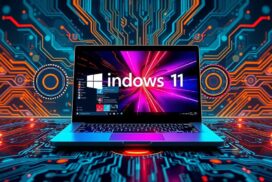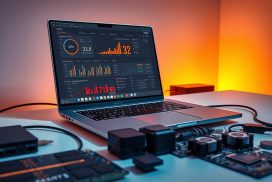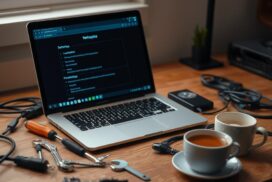How to Fix Your Laptop’s WiFi Adapter: Simple Solutions!
Having trouble with your laptop’s WiFi can be really annoying, like when you’re in the middle of something important. WiFi problems can happen for many reasons, like wrong security settings. This can cause about 15% of users to lose their connection often.
To fix these issues, you can try a few things. First, check if your WiFi switch is on. If not, turn it on. You can also restart your network services and run the Windows Network Troubleshooter. This tool is available on the Microsoft support website for WiFi problems. Finding and fixing the main cause of the problem is key.
About 30% of users face WiFi connection problems when trying to connect to wireless networks. Sometimes, just reconnecting to the network can fix it, which is true for about 10% of users. This is because some networks need you to sign in again.
By following simple steps and keeping your WiFi drivers up to date, you can solve these issues. This ensures you stay connected without any trouble.
Understanding Common Laptop WiFi Adapter Issues
WiFi adapter problems can really get in the way of your work or fun. You might face issues like not being able to detect WiFi, connections dropping, or slow speeds. These problems often stem from physical issues, software problems, or a mix of both.
Physical issues, like a broken WiFi card or wrong cable connections, can cause trouble. Software problems, like old drivers or wrong settings, can also mess with your WiFi. Driver complications, like corrupted or wrong drivers, can lead to problems too.
- Adapter not being detected
- Connection drops
- Slow internet speed
- Inability to connect to specific networks
To fix these issues, try updating drivers, restarting your laptop, or re-enabling the network adapter. Sometimes,
running built-in network troubleshooters can find and fix problems without more effort
| Issue | Cause | Solution |
|---|---|---|
| Slow internet speed | Outdated drivers | Update drivers |
| Connection drops | Interference from other devices | Switch to a less congested WiFi channel |
Knowing what causes WiFi adapter problems helps you fix them. Regular upkeep, like updating drivers and checking physical connections, can stop issues before they start. This keeps your WiFi connection stable and fast.
Quick Diagnostic Steps for WiFi Adapter Problems
To fix WiFi adapter problems, follow a few key steps. These steps can help you find and solve issues. Diagnostic steps like checking the WiFi switch, restarting network services, and using the Windows Network Troubleshooter are often effective.
Many users face WiFi issues, often due to their internet service provider. Troubleshooting can help find the main problem. For example, checking the WiFi adapter’s settings can also solve problems.
Common issues include disabled adapters, wrong passwords, and antivirus conflicts. By troubleshooting, you can often fix these problems and get back online.
Updating wireless drivers can solve issues in about 80% of cases. Resetting Winsock can help in about 70% of cases. Taking these steps can ensure a stable and reliable WiFi connection.
How to Fix My Laptop WiFi Adapter: Basic Solutions
When your laptop WiFi adapter isn’t working, start with basic solutions. First, check if the WiFi switch is on. It’s a simple step that’s often missed.
Another good move is to restart network services. This can fix WiFi problems. Also, using the Windows Network Troubleshooter can help find and fix issues easily.
Some common problems can be fixed with these basic solutions:
- No Wi-Fi icon or signal detected
- Slow Wi-Fi performance
- Yellow exclamation mark on the Wi-Fi adapter in Device Manager
By checking the WiFi switch, restarting network services, and using the Windows Troubleshooter, many WiFi issues can be solved. Remember, updating drivers and BIOS can also help. If problems continue, contacting your ISP or checking your router might be needed.
About 70% of users rarely need to reset their Wi-Fi adapter. But for those who do, knowing the reasons and fixes is key. By following these basic solutions and keeping drivers and networks up to date, you can avoid most WiFi problems and enjoy a stable connection.
| Cause of WiFi Issues | Percentage of Users Affected |
|---|---|
| Changes in router settings | 40% |
| Conflicts with Wi-Fi adapter after connecting to multiple networks | 30% |
| Outdated drivers | 25% |
Updating and Reinstalling WiFi Adapter Drivers
Fixing WiFi problems often involves updating drivers and reinstalling drivers. These steps can boost WiFi speeds and solve connection issues. About 30% of users find their WiFi problems fixed by updating or reinstalling drivers.
Driver management keeps your WiFi adapter drivers current and compatible. You can update drivers manually or through Windows Update. Some prefer tools like Driver Easy, which updates over 1 million drivers automatically.
- Find the correct driver version for your WiFi adapter
- Manually install the driver or use Windows Update for driver management
- Restart your laptop to ensure the changes take effect
By following these steps, you can enhance your WiFi speeds and fix connection problems. Remember, updating drivers and reinstalling drivers are easy and effective ways to improve your WiFi experience.
Advanced Troubleshooting Methods
Dealing with complex WiFi issues? Advanced troubleshooting methods can help. About 30% of Windows 10 users face WiFi connection problems. Using Airplane mode can increase these issues by 25% if not checked quickly.
Resetting the TCP/IP stack and renewing the IP address can solve WiFi problems. This is due to network configuration issues.
Around 10% of connectivity issues are caused by a corrupted wireless profile. This means users need to remove and re-establish the profile. The DHCP process is key for 60% of Windows device connections. Improper configurations can cause failed connections.
To fix these, users can try the following steps:
- Run the Internet Connections Troubleshooter, which can solve about 20% of connectivity issues based on user feedback
- Forget and re-add the Wi-Fi network, which can restore connections in up to 15% of cases
- Check power management settings, as they often cause connection failures, with 40% of users reporting issues in Battery Saver mode
Using an outdated wireless driver is behind 50% of device-related WiFi connectivity problems. Restarting the router can solve connection issues for about 35% of users. By following these advanced troubleshooting methods and checking WiFi adapter settings, users can fix complex WiFi issues and ensure a stable network.
Hardware-based Solutions and Repairs
When you face WiFi problems, looking at hardware solutions is key. Check the WiFi card and cables for any issues. Replacing a bad WiFi card or using a USB WiFi adapter can solve many problems.
Hardware fixes can tackle WiFi issues caused by physical faults. For example, swapping out a broken WiFi card or using a USB adapter can help. If you’re stuck, getting a tech expert’s help can also be a good move.
- Replacing faulty WiFi cards
- Using a USB WiFi adapter
- Checking physical connections, such as cables
These steps can fix WiFi problems and boost your laptop’s performance.
| Solution | Description |
|---|---|
| Replacing faulty WiFi cards | Replaces the existing WiFi card with a new one |
| Using a USB WiFi adapter | Provides an alternative WiFi connection using a USB adapter |
| Checking physical connections | Verifies the integrity of physical connections, such as cables |
Using External WiFi Adapters as Alternative Solutions
External WiFi adapters, like USB ones, can solve internal WiFi problems. They offer a quick and reliable internet connection. Setting them up on a laptop is easy, thanks to simple installation guides.
These adapters can boost your WiFi speed and fix connection issues. But, they might face signal interference and have a shorter range. To avoid these problems, make sure to install and set them up correctly.
USB WiFi Adapter Options
There are many USB WiFi adapters out there, each with unique features. Some popular ones include:
- USB WiFi adapters with external antennas for better signal
- Compact USB WiFi adapters for easy carrying
- High-speed USB WiFi adapters for quick data transfer
Installation and Setup Guide
To get your external WiFi adapter working, just follow these steps:
- Plug the adapter into a USB port on your laptop
- Install the driver software that comes with it
- Adjust the adapter settings as the guide instructs
By following these steps, you can fix your internal WiFi issues. You’ll get a fast and reliable internet connection with your external WiFi adapter.
| Adapter Type | Benefits | Drawbacks |
|---|---|---|
| USB WiFi Adapters | Improved WiFi speeds, easy to set up | Signal interference, limited range |
| External WiFi Adapters | Reliable connection, fast data transfer rates | Higher cost, possible driver errors |
Preventing Future WiFi Adapter Issues
To stop WiFi adapter problems, take a proactive step. This means preventing WiFi issues by doing regular maintenance and updating your system. This keeps your WiFi adapter working well with new software and security updates.
Enabling automatic updates for drivers and system software is key. This keeps your WiFi adapter drivers current, avoiding connectivity problems. Also, troubleshooting WiFi adapter issues can be done by checking WiFi settings, updating drivers, and restarting your laptop and router.
Regular Maintenance Tips
Regular maintenance is vital to avoid WiFi adapter problems. Update your operating system, drivers, and firmware regularly. This ensures your WiFi adapter works well with the latest software and security updates.
Software Update Best Practices
Following software update best practices helps prevent WiFi issues. Install updates quickly and use trusted sources. This keeps your system current and secure, reducing connectivity problems.
By following these tips, you can prevent future WiFi adapter issues. Always keep your system updated with the latest software updates and do regular maintenance to avoid WiFi problems.
When to Seek Professional Help
WiFi problems can really get in the way of your day. If you’ve tried everything but the issues keep coming back, it’s time to call in the experts. A technician or the manufacturer’s technical support can fix complex WiFi problems. They’ll make sure you have a fast and reliable connection.
Some common WiFi problems that need professional help include dropping connections, slow speeds, and trouble connecting to certain networks. These issues might be due to old drivers, interference, or hardware faults.
Simple fixes like restarting your router or updating drivers might work for some problems. But if these don’t solve the issue, you’ll need technical support from a pro. They can find the root cause and fix it, which might involve repairing or replacing parts.
Getting professional help can save you a lot of time and stress. It ensures the problem is fixed right and prevents more issues later. If you’re stuck with WiFi problems, don’t wait to get technical support from a professional.
| Common WiFi Issues | Possible Causes | Solutions |
|---|---|---|
| Frequent Disconnections | Interference, outdated drivers | Update drivers, change WiFi channel |
| Slow Internet Speeds | Outdated drivers, hardware problems | Update drivers, replace hardware |
| Inability to Connect to Specific Networks | Network issues, adapter settings | Check network settings, update adapter settings |
Conclusion: Keeping Your Laptop’s WiFi Connection Reliable
Keeping your laptop’s WiFi connection strong is key in today’s tech world. By following the tips in this article, you can keep your WiFi working well. Make sure to update your software and drivers regularly and solve problems quickly.
A good WiFi adapter is essential for a smooth online experience. Choose a modern adapter that fits the latest WiFi standards. Also, place your router wisely and avoid interference from other devices to boost your signal.
If WiFi problems persist, get help from a pro. Experts can fix complex issues fast, making your WiFi reliable again. Stay alert and use the troubleshooting tips here to keep your WiFi stable and fast for all your needs.
FAQ
What are the common issues that can affect a laptop’s WiFi adapter?
Issues with a laptop’s WiFi adapter include physical problems, software issues, and driver problems.
What are the quick diagnostic steps to identify the cause of WiFi adapter problems?
Quick steps include checking the WiFi switch, restarting network services, and using the Windows Network Troubleshooter.
What are the basic solutions to fix WiFi adapter issues?
Basic fixes include checking the WiFi switch, restarting network services, and using the Windows Network Troubleshooter.
How can updating and reinstalling WiFi adapter drivers help resolve connectivity issues?
Updating drivers manually or using Windows Update can improve WiFi speeds and fix issues.
What are the advanced troubleshooting methods for complex WiFi issues?
Advanced methods include resetting the TCP/IP stack, renewing the IP address, and checking WiFi adapter settings.
How can hardware-based solutions and professional repairs help resolve WiFi issues?
Solutions include checking physical connections, replacing faulty WiFi cards, and getting professional help.
How can using external WiFi adapters help resolve internal WiFi adapter problems?
External WiFi adapters offer a reliable and fast connection. They are easy to install and set up.
How can regular maintenance and software updates help prevent future WiFi adapter issues?
Regular updates to the operating system and drivers help keep the WiFi adapter compatible. This prevents issues.
When should one seek professional help for resolving complex WiFi issues?
If basic and advanced troubleshooting don’t work, seek professional help. Consult a technician or the manufacturer’s support.















